|
GALAPAGOS HOLIDAY CONTINUES: 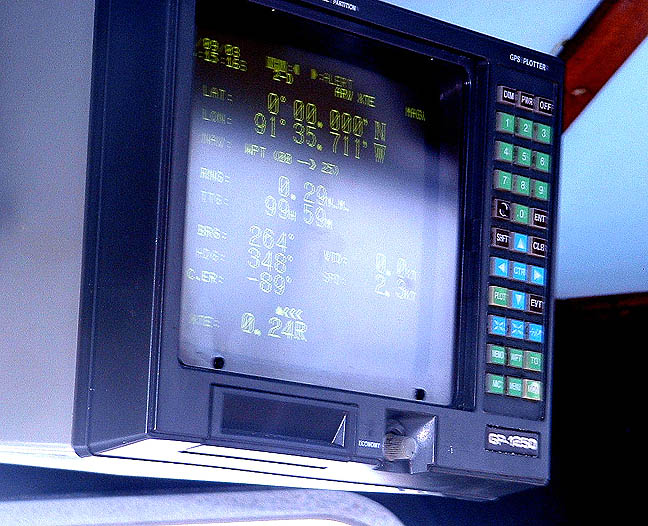
Day 6: We crossed the equator and all piled onto the bridge to see the GPS registering zero degrees zero zero minutes zero zero seconds latitude. We photographed the screen of the GPS system and all had a drink. We wanted to jump in the sea (well, some of us) but we weren't allowed to as it was too rough. This may have been a good decision as we then saw a few hammerhead sharks swimming around and have since learned that one attacked a snorkeller about two months previously. Such incidents are very rare however and we were assured that the shark had mistaken the swimmer for a sea lion due to the lighting conditions (an understandable error). Very shortly afterwords Jean spotted a fin above water which she thought was another shark but it turned out to be something even more interesting, a very large ocean sunfish, which the locals call a mula-mula. They are very rare, grow to ten feet in length and are almost equally deep because they are a kind of oval shape, and have only a residual fin at the back. In colour it was blue and yellow and came right up to the side of the ship. Unfortunately I (David) didn't see it and then went off to get the camera and missed two more! Very little is known about their lifestyle and divers who get pictures of them send them in to dive magazines and they are always published. Jean has since reported her sighting to a scientific team that is researching their habits. They are so rare that a lot of the Galapagos fish books don't even list them. The photos below are library pictures. |
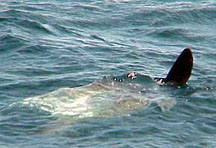 Fin of ocean sunfish |
 Ocean sunfish with diver | 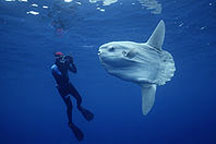 Diver photographing sunfish |
|
On Isabella Island we saw graffiti left by ships that had landed over the last couple of centuries. They left the names of the ships painted in huge letters on the cliffs, which gave a great sense of the history of the islands. |
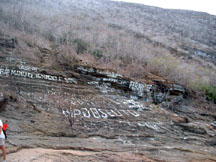 Graffiti Bay Tagus Cove |
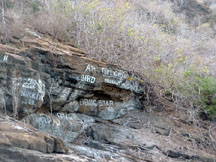 Graffiti Bay Tagus Cove | 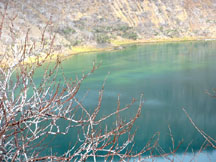 Darwin Bay, Isabela Island |
|
Day 7: Went to James Island where we saw a new species, fur seals. A bit difficult to tell from sea lions, but they have a much thicker coat, are darker in colour, and being nocturnal have bigger eyes. Nocturnal or not we woke a few up to say hello.
|
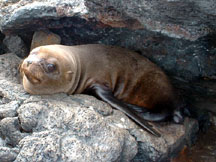 Baby fur seal |
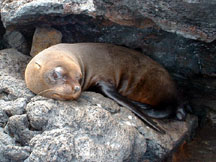 "I'm going back to sleep" | 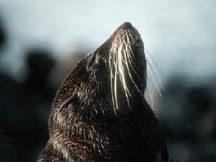 Drowsy adult |
| We have seen nine of Darwin's thirteen finches, and some of them ate the remains of our picnic lunch today. It was differences in the sub species of these finches (particularly in the shapes of their beaks) that gave Darwin the vital clue to the mechanism of evolution; random changes some of which are beneficial and give a survival advantage and are passed on to the next generation. The finches are a bit small and elusive to photograph clearly so below are some library pictures. |
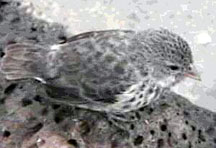 |
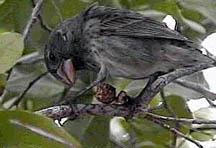 |
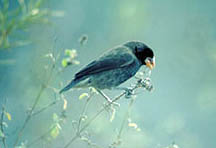 |
|
The finches are still being studied for the light that they can throw on the mechanism and speed of evolution. Peter and Rosemary Grant of Princeton University have been studying them in Galapagos since 1973 and believe they have demonstrated that Darwinian evolution is a much faster process than was previously thought. Darwin is almost a god in Galapagos, loads of streets and hotels in the capital and boats etc. are named after him and his picture is everywhere. No surprises there. Day 8. Before disembarking we had a last trip in the dinghy which turned out to be truly spectacular: We saw loads of white-tip reef sharks resting on the bottom of a mangrove bay, a whole lot of different kinds of ray, some of them bright gold and others with spots and stripes, loads of turtles swimming around, and Franklin and some of the group saw two baby hammerhead sharks, although we didn't. As the creatures were below the water surface photography didn't work too well but here are a few "watery" shots. |
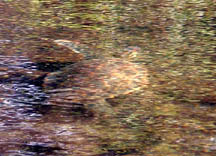 turtle below the surface |
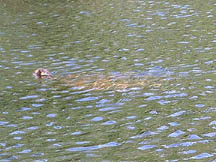 Turtle sticks its head above water | 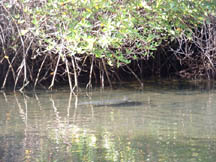 White-tip shark resting |
|
We saw lots of other things over the course of the week but the ones we have described were probably the highlights. Below I have put in a few additional animal pictures that didn't seem to fit anywhere else. |
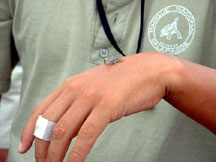 Baby scorpion |
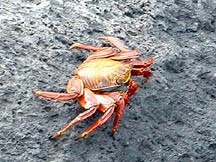 Sally-go-lightly crab | 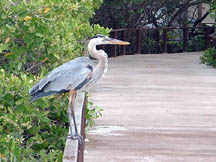 Blue heron |
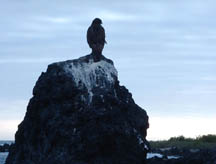 Galapagos hawk |
 Female lava lizard |  Male lava lizard |
|
The final page deals with my two extra days in Santa Cruz during which I went on two boat dives at a site called Enderby Rock near Floreana. These were the two best dives of my life so far! |